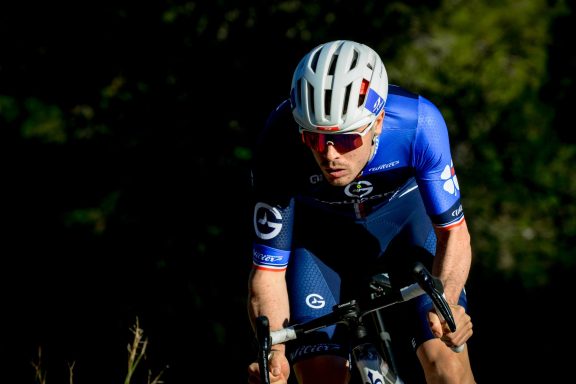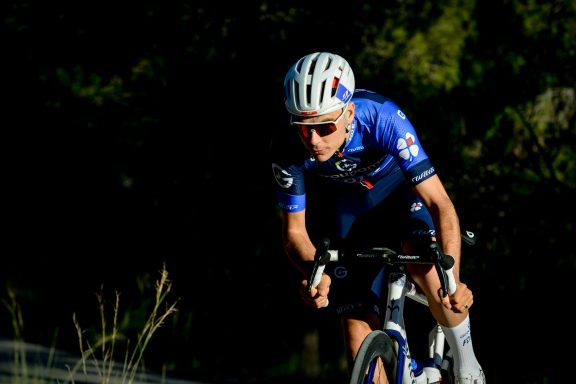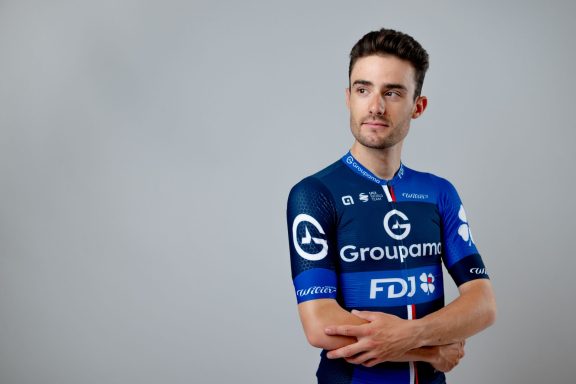In line with its young riders’ development policy, symbolized by the creation of the “Conti” team in 2019, the Groupama-FDJ organization is now adding a new level to its structure. From the 2021 season, the team will start closely monitoring a handful of junior riders and this will come with various and substantial support for the young men involved. In charge of this brand-new program, Benoît Vaugrenard explains to us the project motivations and gives us more details about its content.
Benoît, can you first tell us about the project genesis?
Identifying and developing the young riders are in the team’s DNA. You just have to look at the current WorldTeam squad and ask yourself where the leaders come from. Creating the Conti allowed us to strengthen the package, but we still had to expand it by offering something to the juniors as well. Marc started telling me about this project at the end of 2019, but we did not know yet when and how to initiate it. It slowly got underway last winter, and although we got a bit slowed down in 2020 given the overall situation, we have made pretty good progress in the last few months. Everything has really started to take shape. In order to give a bit of context, we can say that this project is identified as that of the Conti. The objective is to spot the best juniors, nationally or internationally, and then to help them make their way to the top level. Theoretically, some will join the Conti team, whose objective will be to bring them to the WorldTour team. There are now three steps. Our ambition is to give the juniors the tools to succeed, and for those who will follow-up the process, to already have a good understanding of how our organization works. This saves time and brings efficiency.
“Explaining what we intend to do to the parents”
Is it also a way not to miss THE talent?
Like any professional team, the main goal is to spot talents, and hopefully THE phenomenon, and make sure they don’t slip out of our hands. We must be able to identify and attract the talents, whether they are precocious or have a more conventional development. We need to be able to adapt because they don’t all improve at the same speed at this age. You have to assess this parameter in order to give the right support. In short: there are some we need to be cautious with and others we should not slow down. Eventually, no matter how fast they progress, they can all become good or even excellent riders. Still, we have to be honest: we live in an era where the youngsters dominate as soon as they reach the top level. That’s a fact and it has become necessary to fall within this approach. Nevertheless, we need to keep a global point of view and to understand what kind of rider we’re dealing with. To make a pro career, you certainly need physical capacities, but the mindset, the support and the environment are equally decisive factors. It’s up to us to develop the rider in the right way. This sometimes requires long-term work, but there are for sure riders that we don’t want to miss because we see a lot of potential in them.
What is your action plan regarding that matter?
Logically enough, everything starts with detection. With Joseph Berlin-Semon, a coach in the Conti who supports me in this program, we share the U17 and junior races out. We then go on site to look, to scout. In this process, the Madiot Trophy is pretty much the first stage. We obviously follow this competition because of its name, but also because it gathers very good riders from all over France. Among the three riders that we will be monitoring for 2021, two finished on the podium of the Madiot Trophy and won rounds there. It’s a real reference for us, as it kind of is in the team’s DNA. Then, with my “expert” eye, I observe the riders in the race and try to see if there is potential here or there. Later, we initiate the approach first and foremost with the parents. At 16-17, the young rider will obviously say yes straight away if we ask him. I was a rider and I was young, I know how it is. This is why we want to talk to the parents, explain to them what we intend to do. It’s their child, there is school at the same time, and the decision is up to them. We want them to go along with the project.
What does the team concretely provide to a young rider that enters this program?
This is support in several areas. From an equipment point of view, we lend them two bikes: a time trial bike and a road bike. At the beginning of January, the three riders will head to the performance centre in Besançon to set their position. They will return home with their bikes, but also with a power meter, like a professional rider. They will also have road and time trial helmets, even if this also depends on the club they are in and their own needs. It is also planned to be able to help them in their education. If there is a need for quite expensive equipment, or for support, we’re in the capacity to offer them. They also have access to Conti’s internal platform, where they can upload their training. This allows the Conti coaches to be aware of what they do and to potentially give advice. They will also participate in courses and training camps, sometimes with the Conti riders.
“This is not an employment offer”
What kind of training would that be?
We want to raise awareness on various topics, such as dietetics with the team doctor, communication or the powermeter use. For example, the latter is very important, and you obviously have to use it, but you need to do it wisely. At their age, they must also and absolutely work according to their feelings. Otherwise, they risk turning into robots and getting fed up. It’s not just about their sporting future; it’s also about the rest of their lives. It is our role to raise awareness; we are also there to tell them about our experiences, what to do and what to avoid doing. We want to give them a range of knowledge that can help them. They will not all move up to the Conti team, but the goal is for them to accumulate as much knowledge as possible and to get more autonomous thanks to this program. For us, the most important thing is that they end up saying, no matter where they will head to: “It was great, I learned a lot of things and now I will be able to put them into practice.”
Yet, this is not a team.
Absolutely, and it should be made clear: this is not a team, this is a follow-up. We don’t do races. The rider stays in his club. The latter is fundamental in the process, and at this age, we should not uproot the riders. We have very good relations with the clubs, and we present the project to them in full transparency. The rider is the showcase of his club, and having a junior that performs well is the dream of every cycling school. We are now living through a difficult time, we need these “little” clubs more than ever, and we must pay attention to let them breathe. Some are sometimes more structured than others, but all of them are important to us. In line with this philosophy, the riders keep their club coach, but Joseph and I are still available to help them if necessary. There is a framework but we deal on a case-by-case basis.
The goal is then to have a precise and continuous follow-up without it being intrusive?
Completely, and that allows me to name the three riders that we have chosen so far. There are Louka Lesueur, a crossman; Lenny Martinez, a crossman-mountain biker who also does road cycling; as well as Eddy Le Huitouze, who practices both track and road. Let’s take Louka’s example: he has his trainer, and we certainly provide support in the equipment point of view, but that doesn’t change his daily life much. We don’t interfere with the habits he has with his trainer or in his winter preparation. We just follow what he’s doing. We are very careful not to disturb them in their routine. If the rider can’t attend a training camp because he’s got exams, for example, that’s okay. This will not prevent us from continuing the follow-up. We want to be super flexible, and we have to be so at that age. They are not employees of the team either, they are at school. If I have to make them miss a day or two of class, I first call the parents to check if it’s possible. We have to be very careful, because no matter how much we follow them, this is not an employment offer. It is necessary to maintain a “dual” sporting and educational project, though this could suit some more than others.
“We’re not only thinking nationally, but also internationally”
What is planned in terms of training camps?
The first one is set for February, in Calpe, with the Conti team. For the next ones, we do not set a precise schedule yet, firstly because the riders have school, secondly because they have races with their regional or national team, and thirdly because it is just difficult to organize anything with the current situation. We want to plan these camps at the right times, when they have more of an easy period and according to their availability. It is something we want to pay attention to so that the camp proves beneficial and does not interfere with the rest.
Could this support program expand even more?
Right now there are three of them, but nothing is closed other than the philosophy: a few in terms of quantity, but concrete and effective follow-up and support. If by April we spot any riders who might interest us, we will not hesitate to contact them. I am actually talking with some already. We are able to integrate two or three additional young guys in our program. Then, we are not only thinking nationally, but also internationally. If our goal is to find the best ones, then we obviously need to look at what’s going on beyond French borders.
Why did you personally get involved in this project?
Between 2019 and 2020, I was in training for my state diploma. Marc told me about this project and asked if I was interested. I have always kept an eye on the youngsters. I stayed very close to my club in Vannes, where I have been licensed since my early years. Even today, I support them, I follow them and I advise them on a voluntary basis. I’ve always liked to be in the heart of it. Even though I spent seventeen years in the professional world, I never was out of touch. Whenever I could, I would attend youth races close from home and watch the results. Still, this project allowed me to rediscover the basics and to understand what was being done for the young riders in a more general way. It’s interesting to know how they work today and to see the evolution that has taken place since 2000 and my own junior years. It’s pretty exciting, and I’ve already learned a lot in one year. It brings me a lot and it goes with my desire to learn and improve. I might be in charge of the project, but Joseph is also by my side, especially for the training part. This year, I was only disappointed not being able to go to the races as much as I would have liked. I was very excited to go watch the youngsters, but there was almost no competition. Being on the roadside scouting is something fascinating. When you have the eye for it, and the experience, you quickly spot the riders; you can feel things in the way they pedal or behave during the race. You feel if there is something. This is also why I like this role, it is something different than the professional world. I am still in a learning phase and being able to see what is going on elsewhere, in younger categories in particular, is very interesting for me.



No comment